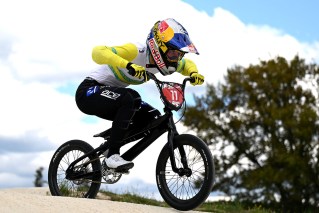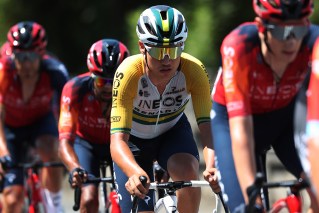Cyclist’s death won’t be last time tragedy unfolds via Google Maps: expert

UK cyclist Mike Hall was competing in the 2017 Indian Pacific Wheel Race when he died. Photo: Facebook
When cyclist Mike Hall died last week on the final stretch of a 5500km endurance cycling race, hundreds of people watched it happen via a dot on a map.
The Indian Pacific Wheel Race (IPWR) began in Fremantle 13 days earlier and was about to end in Sydney as the leader, Kristof Allegaert, closed in on the Opera House finishing line.
Hall was in second place and had left Cooma in NSW just before dawn.
But as he rode along the Monaro Highway just inside the ACT border, Hall was struck by a car and killed.
In Adelaide, avid cyclist Belinda Hoare was trying to find out why Hall’s dot had stopped moving.
She was part of an online community of self-professed “dot watchers” who had been intently tracking the progress of the cyclists online.
“His dot had been moving early in the morning … the dot had stopped. But on social media, on Twitter, a few people remarked there had been an accident and the road was closed,” she said.
Ms Hoare had been following Hall’s dot since he left Fremantle two weeks before and had found herself completely engrossed by the process.
And she wasn’t the only one.
“People (on social media) kept saying ‘I’m getting really obsessed, I can’t stop checking the dots’,” she said.
“You’d go from checking maybe once or twice a day, to checking a couple of times a day, to checking hourly, and then you’d have the map open constantly … you really did feel like you got to know these people.”
A ‘horrible’ wait for more information
It was not unusual that the dot stopped.
The cyclists were all equipped with extremely precise location trackers to make sure they could not cheat and go off course.
People watching online could see precisely where they were at all times on a map — they even knew when the riders had stopped at a public bathroom for a toilet break.
Looks like Mike Hall is stuck behind a road accident on the highway into Canberra #IPWR
— PaulKR (@Paul_K_R) March 30, 2017
“I felt like I was kind of watching over the dots, and having a sense of worrying about people, and almost being a bit protective,” Ms Hoare said.
Sometimes the dots would stop for longer periods when the racers took a pause to eat or rest.
So when Hall’s dot stopped in the early hours of the morning — and confused reports emerged about a death — not everybody jumped to conclusions.
But as minutes ticked into hours, for hundreds of dot watchers staring helplessly at their screens, it became apparent something was seriously wrong.
“There was a horrible moment some time later when it was clear to the dot watching community that it was Mike, even though it hadn’t been named formally in any media outlets,” Ms Hoare said.
“Mike’s dot was moving, but it was moving at a speed that was consistent with it being transported by a vehicle … that was a really horrific moment, where it really was confirmed.”
Social implications largely undiscussed
For those watching online, it was an extremely sad and unusual way to witness a death.
And according to experts, as location sharing services become more common and more public, it is a situation that more people will be forced to confront.
Just last month, Google Maps launched a new location sharing service, allowing users to share their exact location with a contact for a period of time, or until the feature is shut off.
Professor Michael said a man in one of her studies was watching his partner return from work, when she appeared to miss a train and stay behind on the platform.
He became stressed and imagined that she had intentionally stayed behind because she was with someone.
“In actual fact, she hadn’t missed the train, she hadn’t stayed behind,” Professor Michael said.
“It’s just that that’s where the last location ping had occurred.”
Location tracking ‘gamifying’ life
Professor Michael said location data could also cause stress for the person being tracked.
“If it’s tracking them to the wrong location, it makes them very anxious,” Professor Michael said.
https://twitter.com/Ste_Judge/status/847713297419849729?ref_src=twsrc%5Etfw&ref_url=http%3A%2F%2Fwww.abc.net.au%2Fnews%2F2017-04-09%2Fmike-halls-death-watched-on-google-maps-by-thousands%2F8415522
“Because they know they’re being watched by somebody else and they haven’t done anything wrong. They’ve said they were going to be where they were and they are, but the location data is showing the wrong information.”
Professor Michael said people using location sharing services, like parents tracking their kids, or carers tracking people with dementia, needed to be careful not to blindly trust the data.
In the case of Hall’s death, the data was right.
And it is unlikely to be the last time such a tragedy unfolds, with people watching from home via location tracking services.
Professor Michael said that in sport in particular, location services would become more prolific and more public.
“It’s gamifying life,” she said.
“And when you gamify, observers start to flock and to watch, like the dot watchers in this race … it’s being enthralled in the spectacle.”
– ABC








